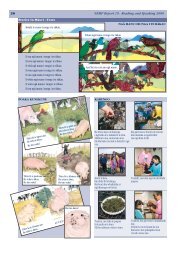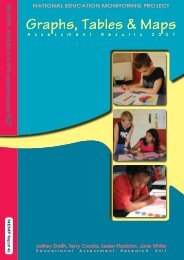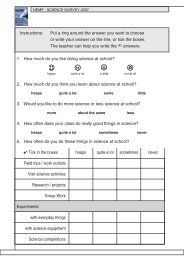mathematics
Mathematics 2001.pdf [33.7 MB] - NEMP - University of Otago
Mathematics 2001.pdf [33.7 MB] - NEMP - University of Otago
- No tags were found...
Create successful ePaper yourself
Turn your PDF publications into a flip-book with our unique Google optimized e-Paper software.
70 Appendix<br />
Main samples<br />
In 2001, 2869 children from 254 schools were in the<br />
main samples to participate in national monitoring.<br />
About half were in year 4, the other half in year 8. At each<br />
level, 120 schools were selected randomly from national<br />
lists of state, integrated and private schools teaching at<br />
that level, with their probability of selection proportional<br />
to the number of students enrolled in the level. The process<br />
used ensured that each region was fairly represented.<br />
Schools with fewer than four students enrolled at the<br />
given level were excluded from these main samples, as<br />
were special schools and Māori immersion schools (such<br />
as Kura Kaupapa Māori ).<br />
Early in May 2001, the Ministry of Education provided<br />
computer files containing lists of eligible schools with<br />
year 4 and year 8 students, organised by region and<br />
district, including year 4 and year 8 roll numbers drawn<br />
from school statistical returns based on enrolments at 1<br />
March 2001.<br />
From these lists, we randomly selected 120 schools with<br />
year 4 students and 120 schools with year 8 students.<br />
Schools with four students in year 4 or 8 had about a<br />
one percent chance of being selected, while some of the<br />
largest intermediate (year 7 and 8) schools had a more<br />
than 90 percent chance of inclusion. In the six cases<br />
where the same school was chosen at both year 4 and<br />
year 8 level, a replacement year 4 school of similar size<br />
was chosen from the same region and district, type and<br />
size of school.<br />
Additional samples<br />
From 1999 onwards, national monitoring has included<br />
additional samples of students to allow the performance<br />
of special categories of students to be reported.<br />
To allow results for Pacific students to be compared with<br />
those of Māori students and other students, 10 additional<br />
schools were selected at year 4 level and 10 at year 8<br />
level. These were selected randomly from schools that<br />
had not been selected in the main sample, had at least 15<br />
percent Pacific students attending the school, and had at<br />
least 12 students at the relevant year level.<br />
To allow results for Māori students learning in Māori<br />
immersion programmes to be compared with results<br />
for Māori children learning in English, 10 additional<br />
schools were selected at year 8 level only. They were<br />
selected from Māori immersion schools (such as Kura<br />
Kaupapa Māori ) that had at least 4 year 8 students, and<br />
from other schools that had at least 4 year 8 students in<br />
classes classified as Level 1 immersion (80 to 100 percent<br />
of instruction taking place in Māori ). Only students that<br />
the schools reported to be in at least their fifth year of<br />
immersion education were included in the sampling<br />
process.<br />
Pairing small schools<br />
At the year 8 level, 9 of the 120 chosen schools in the<br />
main sample had less than 12 year 8 students. For each<br />
of these schools, we identified the nearest small school<br />
meeting our criteria to be paired with the first school.<br />
Wherever possible, schools with 8 to 11 students were<br />
paired with schools with 4 to 7 students, and vice versa.<br />
However, the travelling distances between the schools<br />
were also taken into account. Four of the 10 schools in<br />
the year 8 Māori immersion sample also needed to be<br />
paired with other schools of the same type.<br />
Similar pairing procedures were followed at the year 4<br />
level. Five pairs were required in the main sample of 120<br />
schools.<br />
Contacting schools<br />
Late in May, we attempted to telephone the principals<br />
or acting principals of all schools in the year 8 samples<br />
(excluding the 15 schools in the Māori immersion<br />
sample). We made contact with all schools within a<br />
week.<br />
In our telephone calls with the principals, we briefly<br />
explained the purpose of national monitoring, the<br />
safeguards for schools and students, and the practical<br />
demands that participation would make on schools and<br />
students. We informed the principals about the materials<br />
which would be arriving in the school (a copy of a 20<br />
minute NEMP videotape plus copies for all staff and trustees<br />
of the general NEMP brochure and the information<br />
booklet for sample schools). We asked the principals to<br />
consult with their staff and Board of Trustees and confirm<br />
their participation by the end of June.<br />
A similar procedure was followed at the end of July with<br />
the principals of the schools selected in the year 4 samples,<br />
and they were asked to respond to the invitation by<br />
the end of August. The principals of the 14 schools in the<br />
Māori immersion sample at year 8 level were contacted in<br />
the middle of August and asked to respond by the middle<br />
of September. They were sent brochures in both Māori<br />
and English.<br />
Response from schools<br />
Of the 288 schools originally invited to participate, 282<br />
agreed. Three schools in the year 8 sample declined to<br />
participate: an intermediate school because of major<br />
building work, an independent school because of a clash<br />
with a drama production involving all year 8 students,<br />
and a very small paired school because of the high level<br />
of teaching in Māori in that school. The first two were<br />
replaced within their districts by schools of similar size.<br />
The paired school was not replaced: instead, additional<br />
pupils were selected from the other school in the pair.<br />
An independent school in the Year 4 sample declined to<br />
participate, and was replaced by a school of similar size<br />
in the same district. In the Māori Immersion sample, a<br />
school chose not to participate and was replaced by a<br />
nearby school, while a very small paired school lost stu-






